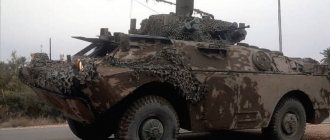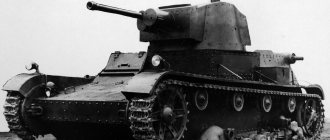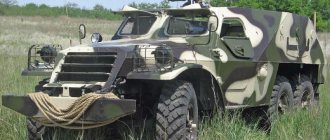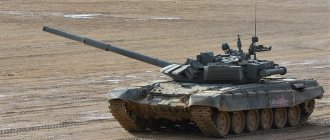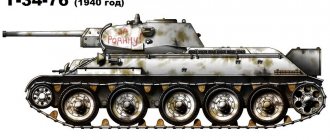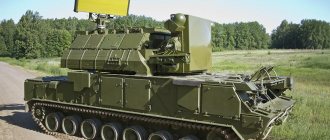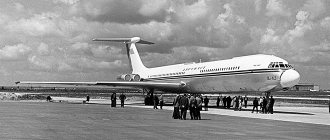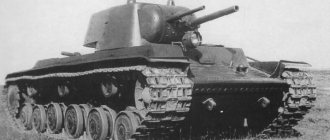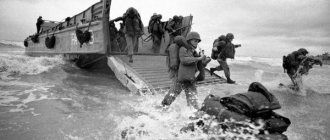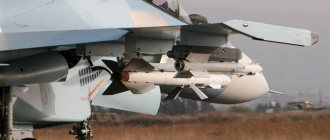The BTR-80 armored personnel carrier has served in the Soviet Army since the mid-80s. In subsequent years, it became the main armored vehicle of the motorized rifle forces of Russia and the former Soviet republics. The armored personnel carrier was also actively supplied for export. However, the insufficient firepower and security of the armored car forced designers to begin developing a new generation vehicle already in the 90s.
In the early 2000s, testing of the new BTR-90 was completed and it was officially put into service. The armored vehicle was actively advertised. But instead, the BTR-82A version, developed in Arzamas, began to enter service - a heavily modernized BTR-80.
Design
The armored hull of the BTR-82A was inherited from its predecessor without changes. It is welded from rolled steel armor 7-10 mm thick. By modern standards, such protection may not be enough even to protect against armor-piercing bullets of normal caliber. The survivability of the crew and landing force, however, is increased due to the appearance of an internal anti-fragmentation lining made of Kevlar. The armored personnel carrier is also vulnerable to shaped charges, up to 40 mm grenades.
The design of the turret has changed - now it is a unified module, equipped with a weapon stabilization system in two planes and electric drives. The 1PZ-2 optical sight with fourfold magnification was replaced by a TKN-4GA combined device with day and night channels.
On the modification of the TKN-4GA-03 sight, the night channel is replaced by a thermal imaging one. The old radio R-173 was replaced by the R-168, which is part of the Aqueduct complex and is capable of receiving digital information.
The TKN-3 commander's observation device was replaced by the TKN-AI with laser illumination. Equipped with BTR-82A and satellite navigation.
The eight-cylinder diesel KAMAZ-740 develops 300 hp. (the BTR-80 engine produced 260 hp), due to which the mobility of the armored personnel carrier did not decrease even with increased weight. The chassis has changed slightly - new cardans have been introduced into the design, and outdated gearboxes have been replaced.
The gearbox remained manual, with five steps. But an auxiliary power unit has not been installed on Russian armored personnel carriers before. Now the electronic equipment of an armored vehicle can function in parking lots without loading the engine or draining the batteries.
The placement of the crew remained the same - the driver and commander in the front seats, followed by the gunner and motorized riflemen. Due to the fact that the turret has become an uninhabited module, the weapon operator does not sit directly in it, but in the fighting compartment.
Six side embrasures for firing from individual weapons have been preserved.
The method of landing troops on the BTR-82A has not changed either - through the side doors or hatches in the roof. The level of comfort in the armored personnel carrier has increased: firstly, the filter ventilation unit can work as an air conditioner, and secondly, the Kevlar lining provides some thermal and noise insulation.
The survivability of the armored personnel carrier in case of damage is ensured by the new fire extinguishing system. But mine countermeasures remain limited. The old housing does not have an optimal configuration for shock wave damping. And its low height does not allow the installation of anti-compression seats.
Armored personnel carrier BTR-82
BTR-82 and BTR-82A are Russian armored personnel carriers developed at the turn of the last and current decades. In fact, the creation of these vehicles is another attempt to modernize the old and well-deserved BTR-80 combat vehicle. The designers set themselves the task of making a vehicle based on the BTR-80 with a higher level of protection, firepower and mobility, as well as significantly improving the operational characteristics of the armored personnel carrier. The development of new vehicles began in 2009, and a year later the BTR-82 and BTR-82A were submitted for testing, after which both modifications of the armored personnel carrier were put into service. Serial production of BTR-82 and BTR-82A has been established at the Arzamas Machine-Building Plant. Currently, more than 1,200 units are in service with the Russian Armed Forces; in addition, the BTR-82A is also in service with the armed forces of the Republic of Kazakhstan (190 units), and Belarus planned to purchase it in 2022. Moreover, Kazakhstan purchased armored personnel carriers even before they were adopted by the Russian army. The BTR-82A is being supplied to Syria, although the exact number of armored personnel carriers sent to that country is unknown.
The BTR-82 model is considered the base model; the BTR-82A armored personnel carrier differs from it only in the combat module with a 30-mm 2A72 automatic cannon. There are four modifications of the armored personnel carrier in total. According to domestic experts, the modification significantly improved the tactical and technical characteristics of armored personnel carriers. In 2014, according to the authoritative international publication Army Technology, the Russian BTR-82A entered the top ten world best vehicles of this class.
History of creation
The BTR-80 was developed in the early 80s on the basis of the BTR-70 armored personnel carrier, taking into account all the shortcomings that were identified in the difficult conditions of Afghanistan. Serial production of the machine began in 1984. The BTR-80 is one of the most famous and honored Soviet armored vehicles, and it can also be called one of the most successful. The BTR-80 had good technical characteristics, a decent level of armor protection, good maneuverability and decent firepower. The BTR-80 was actively used in the Afghan war; later this combat vehicle participated in all conflicts in the post-Soviet space. The armored personnel carrier was actively exported; it is currently in service with 26 armies around the world. However, more than thirty years have passed since the armored personnel carrier was put into service, during which time the requirements for vehicles of this class have changed somewhat. Modern armored personnel carriers are distinguished by high firepower, well-thought-out ergonomics, and their level of security has increased significantly. Particular attention is paid to protecting armored personnel carriers from mines and landmines.
Based on all of the above, it is not surprising that the leadership of the Russian armed forces has plans for a deep modernization of the BTR-80, a vehicle that has long become one of the main “workhorses” of the Russian ground forces. The decision to begin modernization work was made in 2008, and Arzamas Machine-Building Plant OJSC was also selected as the contractor. At the beginning of 2009, design work began; in July of the same year, the design of the new vehicle was approved by the scientific and design council, and the manufacturer began production of a new armored personnel carrier, which was named BTR-82. In the winter of 2010, the vehicle passed state tests, after which the BTR-82 was put into service. In 2011, it began to enter combat units of the Southern Military District. In 2010, the BTR-82A was adopted by the Armed Forces of Kazakhstan; deliveries of vehicles to this country began in 2012.
Description of design
The BTR-82 (and BTR-82A) is a deep modernization of the Soviet armored personnel carrier BTR-80; the shape, dimensions and layout of the hull fully correspond to the Soviet combat vehicle. The control compartment is located in the bow of the armored personnel carrier, the combat compartment, which houses the paratroopers, is in the middle part, and the engine and transmission compartment is located in the rear of the vehicle. The crew of the BTR-82 and BTR-82A consists of three people: a driver, a gunner and a vehicle commander. The landing compartment can accommodate seven soldiers in full equipment with weapons. The landing of fighters occurs through a double-leaf side door (as on the BTR-80), the upper flap of which opens forward in the direction of travel, and the lower one serves as a step. Thus, paratroopers can leave the armored personnel carrier while moving. In addition, two more landing hatches are located on the roof of the hull. The driver and commander of the vehicle have their own escape hatches, which are located directly above their seats. The hull also contains numerous hatches for easy access to the transmission, engine and winch. The car has air conditioning. The weight of the armored personnel carrier increased due to the installation of more powerful weapons on it, but this did not lead to a decrease in the mobility of the vehicle. It was equipped with a new, more powerful diesel engine KAMAZ-740.14 300 (300 hp). The engine is multi-fuel, if necessary it can even be refueled with diesel fuel. The developers managed to slightly increase the security of the machine by covering the inner surface of the body with Kevlar fabric. This not only helps protect the airborne crew and troops from bullets and shrapnel, but also increases the level of thermal insulation and reduces noise inside the vehicle. Although, the level of protection of the new armored personnel carrier remains the same - bulletproof. The mine protection of the BTR-82 and BTR-82A was slightly increased compared to the old BTR-80 due to the use of special energy-absorbing mats inside the hull, the task of which is to absorb part of the explosion energy. However, such protection can only help out when a small charge (anti-personnel mine) is detonated; the BTR-80 and BTR-82A do not have the level of protection against MRAP mines and landmines. Some sources provide information that the seats of the crew and landing troops are equipped with so-called anti-compression seats. They are not attached to the floor, but are suspended inside the housing. This is a standard way to increase the protection of military personnel inside combat vehicles from blast waves. However, installing such seats requires a significant height of the car body. This is why modern armored vehicles made to MRAP standards have a high silhouette. The BRT-82A hull, designed 35 years ago, simply does not have room to install them. The seats in the BTR-82 were modern, but not anti-compression. The BTR-82 and BTR-82A are equipped with a modern fire extinguishing system, which significantly reduced their explosion hazard. According to experts, the complex of work carried out made it possible to increase the overall security of new machines by approximately 20%.
A new combat model was installed on the BTR-82A, which significantly increased the combat power of the vehicle. It includes an automatic 30-mm cannon 2A72 and a PKTM machine gun. The gunner's position was moved from the turret to the vehicle body. The module is equipped with a two-plane stabilizer, which allows the gunner to fire while the vehicle is moving, and electric drives. In addition, the BTR-82 and BTR-82A are equipped with a combined round-the-clock stabilized sight TKN-4GA, which makes it possible to use the weapons of the combat module both day and night. The sight is equipped with a channel for remote detonation of ammunition. The gun's ammunition capacity is 300 shells. Due to the increase in the weight of the armored personnel carrier, the developers had to seriously rework the chassis of the vehicle. The BTR-82 was equipped with new wheel gears and modern driveshafts. Shock absorbers with increased energy intensity were installed on the armored personnel carrier. The BTR-82 is equipped with drive axles with a gear-type forced locking differential. The BTR-82 is equipped with an additional 5 kW power unit, which provides energy to all vehicle systems during a stop. The armored personnel carrier's mileage before the first major overhaul is 50 thousand km.
Project evaluation
The BTR-82 and BTR-82A armored personnel carriers are certainly a big step forward compared to its predecessor, the BTR-80. The new vehicles have higher firepower, their security and vehicle mobility have been somewhat improved. However, it’s hard to call the BTR-82A a “breakthrough.” In essence, this is the good old BTR-80 with a new combat module, a more powerful engine and a redesigned chassis. The armored personnel carrier retains the old layout of the Soviet vehicle, which can easily be attributed to one of its main shortcomings. Due to the rear location of the engine and transmission compartment, the exit for the paratroopers had to be left on the side. In addition, it is quite narrow and uncomfortable. Most modern cars of this class have a spacious exit at the rear. The crew seats are not particularly comfortable. If the driver is killed or wounded, getting him out of the workplace will be very problematic. The quality of visibility from the driver’s seat (especially to the rear) raises no less questions. The troop compartment of an armored personnel carrier is cramped; there are no energy-absorbing seats, which are an almost constant attribute of armored personnel carriers today. The protection of the machine, especially from the effects of a blast wave, is also insufficient.
Specifications
Weight, t – 15.4 Engine power, kW (hp) – 220 (300) Maximum highway speed, km/h – up to 100 Maximum afloat speed, km/h – 9 Fuel reserve highway, km – 600 Armament: 30-mm automatic cannon 2A72 (b/c 300 rounds in two belts) 7.62-mm machine gun PKTM (b/k 2000 rounds in one belt) Night sight TKN-4GA-02 Engine – Turbodiesel KAMAZ-740.14-300
Armament
The basic armored personnel carrier BTR-82 retained the weapon system first introduced on the BTR-60PB. This is a large-caliber (14.5 mm) KPVT machine gun and a coaxial PKT of 7.62 mm caliber. The high armor penetration of the KPVT allows it to hit light armored vehicles, but its capabilities are not enough to combat more protected targets or to defeat infantry in shelters.
The BTR-82A is significantly more powerfully armed. Its turret module is equipped with a 30 mm 2A72 automatic cannon designed by Gryazev and Shipunov. This weapon differs from the 2A42 cannon (used, in particular, on the BTR-90 armored personnel carrier) in the principle of its automation. A gun powered by a long barrel stroke. It became possible to install even on light equipment - the recoil was reduced so much. On the other hand, the rate of fire dropped.
The gun can use all 30x165 mm ammunition designed for the 2A42.
These also include armor-piercing sub-caliber projectiles that penetrate 47 mm inclined armor at ranges of up to 1 km. The effective firing range of high-explosive fragmentation shells exceeds 3 km. Selective power allows you to instantly switch between two belts loaded with different types of ammunition.
The gun's ammunition capacity is about 300 rounds. The coaxial machine gun is fed by a single belt containing 2,000 rounds of ammunition. Note, however, that this is not the first time that such weapons have been installed on armored personnel carriers. The BTR-80A, which was put into service back in 1994, was armed in exactly the same way.
Performance characteristics of the BTR-82A
Let's compare the BTR-82A with its immediate predecessor of the “eightieth” series and the LAV-25 armored personnel carrier, which is in service with the American Marine Corps.
| BTR-80A | BTR-82A | LAV-25 | |
| Crew+troops | 3+7 people | 3+7 people | 3 + 6 people |
| Weight | 14.5 t. | 16 t. | 12.8 t. |
| Maximum speed | 80 km/h | 80 km/h | 100 km/h |
| Power reserve | 600 km | 700 km | 660 km |
| Length | 7.6 m | 7.6 m | 6.4 m |
| Height | 2.4 m | 2.7 m | 2.7 m |
| Armament | 30mm automatic cannon, 7.62 mm machine gun | 30mm automatic cannon, 7.62 mm machine gun | 25mm automatic cannon, 2 7.62mm machine guns |
So, the BTR-82A “gained weight” compared to its ancestor, but this did not affect its mobility, and its range even increased. The American armored personnel carrier, which entered service back in the 80s, was already armed with an automatic cannon (albeit of a smaller caliber) in a turret with hydraulic drives, and was even superior to the BTR-80 in mobility.
However, the high mobility of the LAV-25 was achieved largely due to thin armor designed to protect against machine gun bullets. During the modernization and bringing of armored personnel carriers to the LAV-25A2 standard, the armor was strengthened and provided protection from 30mm shells for frontal armor and from 14.5mm bullets - “in a circle”. It is not reported how much the weight increased, but the vehicles retained the ability to airdrop. In general, we can assume that the LAV-25A2 is approximately equivalent in quality to the BTR-82A.
2S28 "Sprut-K"
The idea and ideology of building a new machine belonged to Alexander Grigorievich Masyagin. In 1989, a preliminary design of a promising armored personnel carrier was created. The main task was to create a combat vehicle with fire capabilities and security at the level of modern infantry fighting vehicles. A prerequisite was the presence of a rapid-firing automatic cannon and an anti-tank missile system. The project was presented to the Main Armored Directorate, where the idea was approved: development work was opened to create a promising wheeled armored combat vehicle. The theme was named “Rostock”.
Exploitation
Even before its official adoption in Russia in 2010, the BTR-82A was ordered by the armed forces of Kazakhstan. 70 armored vehicles were delivered there. And since 2011, Russian troops also began to switch to new armored personnel carriers. In 2022, the number of operational BTR-82A units exceeded 1,400 units. It is worth noting that these are not only “newly produced” cars. Old BTR-80s are upgraded to BTR-82 standard during major overhauls. Such armored personnel carriers receive the designation BTR-82AM.
It is interesting that although the “machine gun” BTR-82 was considered the basic version, there is no information that such armored personnel carriers were delivered anywhere.
Moreover, it is not even listed in the product lists on the Arzamas Machine-Building website. Obviously, it is not currently being produced and the main model should still be considered the BTR-82A with “cannon” armament.
Already in 2015, a modification of the BTR-87 appeared. Following modern requirements, the designers moved the engine compartment to the nose of the hull. The car, however, still remains experimental. Since 2015, it has been known about the use of BTR-82A in Syria. It is believed that the vehicles arrived in the combat zone with Russian troops, and were then transferred to the Syrian army (although they are not officially in service). The results of operation and combat effectiveness of armored personnel carriers have not yet been reported in detail.
After the BTR-82A was put into service, some publications rushed to proclaim it “the best in the world” (even if the BTR-90 had previously been certified in the same way).
And, upon closer examination, “ninety” fit this definition more than “eighty-two.” Of course, the adoption of the BTR-82A made it possible not to write off old armored personnel carriers, but to improve their performance during overhauls. On the other hand, the “ninetieth” still had more powerful weapons and better protection.
A possible explanation for the abandonment of a more modern vehicle in favor of modernizing the old one could be the emergence of the promising Boomerang family of armored personnel carriers. Indeed, there is no point in expanding the production of new equipment if an even more advanced one is already “on the way.” But if the Boomerangs, following the Armata tank, are considered too expensive, the Russian army may remain for a long time improved, but not at all new, BTR-82A.
Project evaluation
The BTR-82 and BTR-82A armored personnel carriers are certainly a big step forward compared to its predecessor, the BTR-80. The new vehicles have higher firepower, their security and vehicle mobility have been somewhat improved. However, it’s hard to call the BTR-82A a “breakthrough.” In essence, this is the good old BTR-80 with a new combat module, a more powerful engine and a redesigned chassis.
The armored personnel carrier retains the old layout of the Soviet vehicle, which can easily be attributed to one of its main shortcomings.
Due to the rear location of the engine and transmission compartment, the exit for the paratroopers had to be left on the side. In addition, it is quite narrow and uncomfortable. Most modern cars of this class have a spacious exit at the rear.
The crew seats are not particularly comfortable. If the driver is killed or wounded, getting him out of the workplace will be very problematic. The quality of visibility from the driver’s seat (especially to the rear) raises no less questions. The troop compartment of an armored personnel carrier is cramped; there are no energy-absorbing seats, which are an almost constant attribute of armored personnel carriers today.
The protection of the machine, especially from the effects of a blast wave, is also insufficient.
Currently, the Arzamas Machine-Building Plant is working on creating several more modifications of the BTR-82. However, it should be noted that the line of Soviet armored vehicles BTR-60/70/80 is obsolete and no modernization can change this fact. To give the army a truly modern vehicle, it will have to be developed from scratch.

